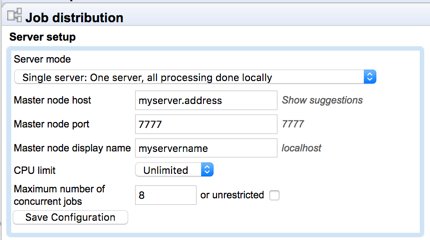Model III: Single Server setup
In this model, the master and execution node functionality is carried out by a single CLC Server instance. Here, the CLC Server software is installed on a single machine. Jobs submitted to the server are executed on this same machine.
To designate the system as a single server, after installation and starting the server, go to the Job distribution tab in the web administrative interface:
Configuration (![]() ) | Job distribution (
) | Job distribution (![]() )
)
Select the option SINGLE_SERVER from the drop down list of Server modes.

Figure 6.10: The configuration options for the types of machines running the CLC Server. The choices of relevance under normal circumstances are SINGLE_SERVER and MASTER_NODE. An administrator will not usually need to manually choose the Execution Node option. This option is there primarily to allow for troubleshooting.
You can then configure aspects of the server:
- Master node host - usually set to localhost for Single server mode. Click on the "Show suggestions" text next to this field to see information about the server that can be useful if localhost is not a suitable option for your setup.
- Master node port - usually 7777.
- Master node display name - the name shown in the top bar of the web interface for the server.
- CPU limit - The maximum number of CPU the CLC Server should use. This is set to unlimited by default, meaning that up to all cores of the system can be used.
- Maximum number of concurrent jobs - Limit the maximum number of jobs that are allowed to run concurrently on the single server. For further information about this setting see section 6.6.3.

Figure 6.11: Configuring a single server.
